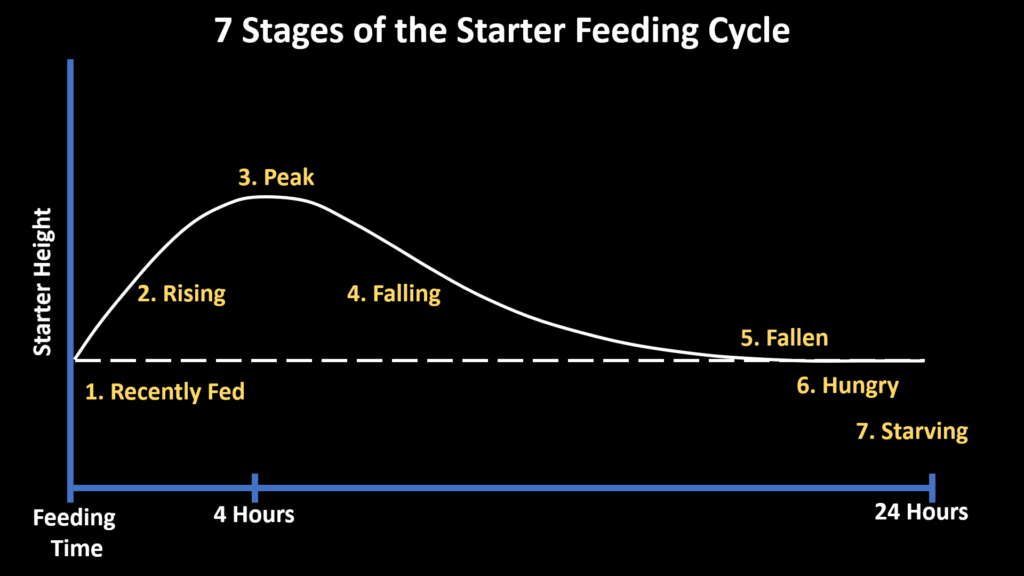Starter Strengthening
Frequently Asked Questions
A sourdough starter is a living organism and it periodically goes through changes where it can weaken over time. This is perfectly normal. Also, if you feed your starter a new type of flour, or perhaps during the change of seasons, you will see your starter strength change over time.
One of the critically important skills for you to learn as a sourdough baker is to learn how to read and strengthen starter.
Check out the videos below for detailed instruction on how to identify a weak, acidic starter, and how to remediate it.
In general, a strong starter should double in volume after a 1:1:1 feeding in about 4-6 hours at a temperature of approximately 75F/24C.
The rising time of a starter is significantly influenced by temperature. Many people mistake a weak starter for simply a cold starter. A very strong starter will rise slowly at low temperature, but it will rise rapidly at a warm temperature. A weak starter will not rise rapidly at either cool or warm temperatures.
The type of flour used in your starter and the hydration percentage can also impact how much of a rise your starter will display. Low protein flours, like all-purpose flour, will not rise as much as higher protein flours.
Here is an example of what a strong starter looks like. This starter is 50% bread flour and 50% whole wheat. It is 100% hydration, and it was about six months old at the time this video was produced.
To strengthen your starter, you need to understand the biology of what is happening, and you need to be able “read” your starter to understand when its yeast population is at its peak. Then use a combination of feeding ratios and feeding intervals to strengthen your starter. See videos below for examples.
There are three techniques for strengthening a weak starter:
- Change the feeding interval
- Change the feeding ratio
- Change the type of flour
Please note, by changing the temperature of your starter you can change the speed of the rise, but this is not necessarily changing the strength of the starter. Fermentation is temperature sensitive, and by increasing temperature you can create the illusion of stronger starter because it will rise faster. But a faster rise due to temperature change alone is not indicative of a change in starter strength.
To accurately measure the change in your starter’s strength, you must ensure that you are measuring your starter’s behavior at the same temperature. Warm starters will always rise faster than cool starters, but that does not mean the starter is stronger (it is just warmer!)
Changing the feeding interval, or frequency, is the single most important tool in strengthening a starter.
By simply catching your starter near its peak and refeeding at that time, you can significantly strengthen a weak starter. If you discard and feed at peak, you are carrying over the largest concentration of yeast cells possible in your carryover starter for the next feeding.
By using a technique known as “Peak-to-Peak” feeding, you should ignore the clock and feed your starter shortly after it peaks. By doing this three or four times in a row, you can substantially grow your yeast population and strengthen your starter.
The video “How to Strengthen a Weak Starter” describes the “Peak-to-Peak” feeding method.
The feeding ratio (e.g., 1:1:1 or 1:2:2) does not directly impact the strength of a starter. You cannot increase a starter strength by feeding it more food. You cannot force-feed a starter. In fact, if you are discarding at each feeding, then trying to force-feed your starter can actually weaken it, if you are discarding before your starter has peaked.
Discarding and refeeding a weak starter before it peaks, makes it weaker.
The feeding ratio is a technique used to strengthen your starter by simply controlling the timing of when your starter peaks. Your starter will strengthen by feeding it as close to peak as possible, but if your starter is peaking while you are sleeping or at work, for example, then you are not strengthening it. By changing the feeding ratio, you can elongate the duration of time required for the starter to peak. If this enables you to catch your starter closer to peak then the feeding ratio is contributing to the strengthening regimen, but not by actually changing the strength biologically or chemically because you cannot force feed a starter by giving it more food than it needs.
videos
How to Strengthen a Weak, Acidic Sourdough Starter
Are you struggling with a sluggish, weak starter?
Most weak starters are actually acidic starters. In this video, learn the science behind starter acidity and learn the tools and techniques to deacidify a weak, acidic starter. This video includes the Peak-to-Peak feeding method and other tips to get your starter in top shape.
Note: This video is for mature starters. If you are struggling with a new starter, check out my tools and tips here.
How to Strengthen a Weak Starter
This innovative video takes a deep dive into understanding the Seven Stages of the Starter Feeding Cycle and describes methods for strengthening a weak starter including the Peak-to-Peak feeding method which was popularized by this video.
How to Double your Starter Strength in Six Days (or less)
This video demonstrates how to strengthen a weak starter simply by changing the starter feeding ratio and feeding interval. Over a six day period, the starter strength is more than doubled. This ground-breaking video includes innovative new methods for measuring the true strength of a sourdough starter.
This video is an excerpt from the video, “When is Bulk Fermentation Done: Episode 6 – Starter Strength and Leaven Percentage.
The 7 Stages of the Starter Feeding Cycle
This video clip is an excerpt from the video, “How to Strengthen a Weak Starter.” This clip shows examples of what a starter should look like at each stage of the starter feeding cycle. “Reading your starter” is a critically important skill for the sourdough baker.
The BIGGEST MISTAKE You Can Make With Your Sourdough Starter: Premature Discarding
Can you kill your starter by using the wrong feeding method?
You can’t actually kill it, but many bakers mistakenly discard and refeed their starters so frequently that they weaken it to the point of near-death. Learn how to avoid this mistake.
Your starter is like a house plant. The bubbles are the leaves. If you don’t see bubbles, don’t prune (discard), water and feed it! Give it time.
Additional resources
A Close Look at Sourdough Starter, Vanessa Kimbell, The Sourdough School: Here is an interesting article from Vanessa Kimbell looking at the microbiology of her sourdough starter.

